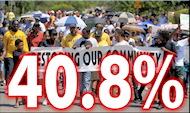NCLB + Title I + The Stimulus package = a Loophole: Increased vigilance required in education
I’ve never been a big fan of the No Child Left Behind Act. I can certainly appreciate and even applaud the goals of the bill. But as a practical matter, its reliance on high-stakes testing as a catalyst for improvement is an ineffective means to increase educational attainment. In truth, the achievement gap can no more be closed by testing than a fever could be cured with a thermometer. Reform is a matter of methodology, not measurement, and in that respect NCLB falls short.
But one thing that NCLB Has done, and done quite effectively, is it has kept the achievement gap and the disparities between high poverty urban schools and their suburban counterparts at the forefront. Under NCLB, districts are forced to generate and respond to disaggregated data, to make that data available to parents, and to take deliberate and conscious steps towards improving student achievement and eliminating disparities. Title I schools (those being schools with high concentrations of economically disadvantaged students) face stiff sanctions under NCLB if they are not able to show that all sub-groups within the school are meeting established standards referred to as Adequate Yearly Progress (AYP).
Title I schools are subject to these penalties and sanctions because they receive allocations of Federal funds specifically intended to mitigate the challenges posed by urban poverty. Non-Title I schools are exempt from NCLB sanctions, but may be subject to guidance provided from the State.
NCLB Sanctions
First Year a school does not make Adequate Yearly ProgressWhile the “Carrot and Stick” approach of Title I funding coupled with NCLB sanctions, is an ineffective means of improving educational attainment, it does provide additional measures of transparency and accountability, and a concrete mechanism for forcing institutional reform. Hence, it is in some ways both a blessing and a curse…
No Sanction
Second Year a school does not make Adequate Yearly Progress
No Sanction
Third Year a school does not make Adequate Yearly Progress
“On Improvement”
The school must write a School Improvement Plan and must offer parents Choice
Fourth Year a school does not make Adequate Yearly Progress
“On Improvement”
The school must offer Choice and Supplementary Educational Services
Fifth Year a school does not make Adequate Yearly Progress
“Corrective Action”
The school must offer Choice, Supplementary Educational Services, and take at least one of the following Corrective Actions:
replace school staff relevant to the failure institute and implement a new curriculum significantly decrease management authority in the school appoint outside experts to advise the school extend school year or school day restructure internal organization of the school
Sixth Year a school does not make Adequate Yearly Progress
“Restructuring”
The school must offer Choice, Supplementary Educational Services, and a plan to restructure that accomplishes at least one of the following:
Reopens school as a public charter school Replaces all or most of school staff, including the principal Enters into a contract with an entity, such as a private management company, with a demonstrated record of effectiveness to operate the school Presents some alternative major restructuring of the school's governance arrangement
Seventh Year a school does not make Adequate Yearly Progress
“Implement Restructuring Plan”
The school begins operations under an alternative governance plan
Concordantly, school districts rarely request the full amount of Title I funding for which they'd qualify .
Any school wherein 75% or more or the students qualify for a free or reduced lunch is classified as a Title I school and therefore receives supplementary funding from the Federal Government. However, any school with a “free or reduced” student population of 35% or greater Could be classified as a Title I school if requested by the Local School district. But most districts opt to maintain the 75% Title I threshold, forgoing the potential of additional supplementary funding, because of the harsh sanctions and scrutiny that Title I funding often imposes.
But as our economy languishes, many school districts (including my own) facing budget shortfalls, find themselves faced with a myriad of difficult decisions. In response, the Obama administration has released 2 years of increased funding for Title I schools under the American Recovery and Reinvestment act (ARRA). And given the current economic climate, for many districts, this funding could not have come at a better time.
In order to take advantage of this additional funding and to maximize the potential allocations, many districts (including my own) are choosing to reduce their Title I thresholds below the mandatory 75%. Here in Wichita, USD259 has chosen to reduce their Title I threshold to include any school wherein the ‘free or reduced’ student population meets or exceeds 55% -- which encompasses a full 35% of the district. And the same scenario is being replicated in districts across the country.
As an advocate, I would ordinarily be pleased with the additional transparency and accountability that a shift to Title I provides, …but you see, there’s just one little problem with the timing…
The increased funding provided by ARRA is only available for two years. And if you scroll up and take another look at the Title I table, you’ll note that there are No Title I sanctions for the first two years of the program. So while the ARRA funding provides districts with the incentive to increase their number of Title I schools, that funding ends two years into the program, before any sanctions or mandatory reforms would be applied. And there is no prohibition against a district lowering their Title I threshold, applying for and using the additional ARRA/Title I funding, then raising the threshold back to 75% at the end of the two year period, before any mandatory NCLB reforms were prescribed.
So fellow NAACP’ers, advocates, and activists, we need to keep our eyes on this… We need to make sure that we are paying attention as new educational data becomes available over the next couple years. And we need to make sure that where problems are identified, that our local districts move forward with programmatic change and reforms even after the funding ceases and the thresholds are increased….











